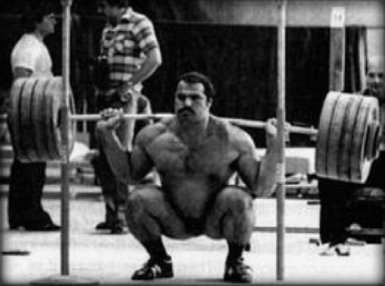A few days ago I put a post out on social media about the squat being one of my “must have” exercises in a strength and conditioning program. That brought up a number of questions for me about which type of squat is best. So I thought that would be a great topic for today’s blog to at least share my thoughts on this one.
First, let me get the disclaimer out of the way. I’m not a clinician, I don’t diagnose or treat things. I think this is a great approach if you have lots of time in a small-group or one-on-one environment and if you are in an environment with a lot of marketing and other businesses that you are competing with. This approach doesn’t hold up very well in the world where you are lucky to get your athletes 30-40 minutes a day and they may be in groups of 40-60 at a time. So, this post is geared towards that world.
To me, the back squat is probably the single most essential exercise for athletes. One way or another it uses almost the entire body. It strengthens the skeleton. It teaches the lower body and core to exert force against the ground in a coordinated manner. The movement pattern is similar to many sporting skills. It develops the muscles and soft tissue of the lower body and core. Etc. In other words, there’s one exercise that does an awful lot of things so it is a great return on the time spent on it.
It has another great benefit, it’s relatively easy to learn and coach. Now, don’t get me wrong here. There are lots are technical errors that athletes commit with the squat, but it’s not as difficult as teaching a power snatch (for example). So there’s less up-front time spent on instruction and more time being spent on beneficial training.
I organize training into a few different types of training days in the weight room (this is off-season):
- Maximal strength: This is a total body workout using 4-5 exercises. It’s generally 80% plus depending on the athlete and the time of year.
- Power: This workout is generally the day after the maximal strength workout. This is where Olympic lifts, throws, and plyometrics would be used.
- Hypertrophy: This is your higher volume, 60-80% intensity type training.
I rarely mix these training sessions up. In season involves lots of complex and contrast training.
Much of the year has the back squat as the first exercise on the maximal strength day. I will sometimes substitute the front squat on these, but only with athletes that are very comfortable with that exercise. Now, the hypertrophy day is when I’ll incorporate different types of squats as I don’t feel the need to back squat twice a week. My two favorites are the front squat and the split squat.
The table below shows a sample week of general prep-type training.
| Monday | Tuesday | Wednesday | Thursday | Friday | |
| Strength | Back squats, 3×6-10×85%
Romanian deadlifts, 3×6-10 Bench press, 3×6-10×85% Bent-over rows, 3×6-10 Kettlebell press, 3×6-10 |
Front squats, 3×8-12×70%
Lunges, 3×8-12 Good mornings, 3×8-12 Reverse hypers, 3×12-15 |
Incline press, 3×8-12×70%
Pull-ups, 3xMax Front raises, 3×12-15 Side raises, 3×12-15 Rear delt raises, 3×12-15 Superset: Biceps/triceps, 3×12-15 |
||
| Power | Power clean, 3×4-6×70%
Clean pulls, 3×4-6×80% Push jerk, 3×4-6×70% Counter-movement jumps, 3×10 Squat jumps, 3×10 |
||||
| Speed | Falling starts, 3×10 meters
Standing starts, 3×10 meters
|
Standing starts, 3×40 meters
Bounds, 3×40 meters |
|||
| Agility | Fundamental skills: 3×5 yards each for shuffling, backpedaling, start/stop/ start | ||||
| Conditioning | Circuit: kettlebells, jump rope, core training, 20 minutes |
If I don’t have four days a week, then I’ll combine the last two days and superset the exercises (so maybe do a set of front squats and then a set of pull-ups). I’ll rotate between front and split squats every other mesocycle. In other words, I’ll spend about four weeks with the front squat and then about four weeks on the split. This will continue until I move into heavier, more specific training.
In specific and pre-competition training, I focus on the back squat and the split squat, I generally drop the front squat. In this type of training, there may be two maximal strength days and two power days per week. There’s also a lot more sprinting and agility work. I like to use the split squat to help transfer to sprinting and agility. The table below shows an example of this.
| Monday | Tuesday | Wednesday | Thursday | Friday | |
| Strength | Back squats, 3×2-4×90%
Deadlifts, 3×2-4 Bench press, 3×2-4×90% Kettlebell rows, 3×2-4 Stand. Military press, 3×2-4 |
Split squats, 3×4-6×85%
Good mornings, 3×4-6 Incline press, 3×4-6×85% One-arm dumbbell rows, 3×4-6 Seated military press, 3×4-6 |
|||
| Power | Power clean, 3×4-6×70%
Clean pulls, 3×4-6×80% Push jerk, 3×4-6×70% Counter-movement jumps, 3×10 Split scissor jumps, 3×10 Jumps to a height, 10x |
Power snatch, 3×4-6×70%
Split clean, 3×4-6×70% Kettlebell pulls, 3×4-6 Standing long jump, 3×10 Hurdle jumps, 3×10 meters
|
|||
| Speed | Standing starts, 3×10 meters
Resisted sprints, 3×20+20 meters
|
Standing starts, 3×60 meters
Flying sprints, 3×20+40 meters Bounds, 3×40 meters |
|||
| Agility | Reactive drills | Small-sided games | |||
| Conditioning | Circuit: body weight, kettlebells, jump rope, core training, 20 minutes |
While this isn’t an article about speed, agility, and conditioning-type training I think it’s important to see the program in total because nothing exists in isolation. The idea here is to keep the workouts pretty brief and focus on what’s absolutely essential. This approach also works for a lot of sports.
So is there a “best” version of the squat? For me there are three that I really like and they are my focus. Having said that, I always come back to the back squat as my foundational lift.



